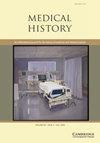The expansion of medical education in the Dutch East Indies and the formation of the Indonesian medical profession
IF 1.1
2区 哲学
Q4 HEALTH CARE SCIENCES & SERVICES
引用次数: 0
Abstract
In 1851, the colonial administration of the Dutch East Indies established a two-year program to educate young Javanese men to become vaccinators in Batavia (today’s Jakarta). During the following sixty years, the medical curriculum was expanded several times; in 1913, it consisted of a ten-year program. In 1927, the Batavia Medical School, granting degrees equivalent to those of Dutch university-affiliated medical schools, commenced operations. Consequently, a steadily increasing number of Indonesian physicians with various credentials were employed by the colonial health service, plantations, sugar factories and mines, or established private practices. They became a social group that occupied an ambiguous and even paradoxical position somewhere between Europeans and the indigenous population. During the 1910s, this inspired these physicians to obtain credentials and professional recognition equal to those of their European colleagues. Several of them became active in journalism, politics and social movements. During the 1920s, several became radicalised and criticised the nature of colonial society. In the 1930s, following the increasingly repressive nature of colonial society, most of them remained active in the public sphere while a small group dedicated itself to improving medical research and health care. After the transfer of sovereignty from the Netherlands to Indonesia on 27 December 1949, this small cadre reestablished medical education and health care, and built the Indonesian medical profession.荷属东印度群岛医学教育的扩展和印度尼西亚医学界的形成
1851 年,荷属东印度群岛殖民政府在巴达维亚(今雅加达)设立了一个为期两年的项目,培养爪哇青年男子成为疫苗接种员。在随后的六十年中,医学课程几经扩充;1913 年,该课程改为十年制。1927 年,巴达维亚医学院开始招生,该校授予的学位等同于荷兰大学附属医学院的学位。因此,越来越多拥有各种资质的印尼医生受雇于殖民地卫生服务机构、种植园、制糖厂和矿山,或开设私人诊所。他们成为了一个社会群体,在欧洲人和土著居民之间占据着一个模糊甚至矛盾的位置。在 1910 年代,这激励着这些医生获得与欧洲同行同等的资格证书和专业认可。他们中的一些人开始积极参与新闻、政治和社会运动。20 世纪 20 年代,其中一些人变得激进起来,对殖民社会的本质提出了批评。20 世纪 30 年代,随着殖民社会的压迫性日益增强,他们中的大多数人仍然活跃在公共领域,而一小部分人则致力于改善医学研究和医疗保健。1949 年 12 月 27 日荷兰将主权移交给印度尼西亚后,这一小部分人重新建立了医学教育和医疗保健,并建立了印度尼西亚医学界。
本文章由计算机程序翻译,如有差异,请以英文原文为准。
求助全文
约1分钟内获得全文
求助全文
来源期刊

Medical History
医学-科学史与科学哲学
CiteScore
1.60
自引率
0.00%
发文量
25
审稿时长
>12 weeks
期刊介绍:
Medical History is a refereed journal devoted to all aspects of the history of medicine and health, with the goal of broadening and deepening the understanding of the field, in the widest sense, by historical studies of the highest quality. It is also the journal of the European Association for the History of Medicine and Health. The membership of the Editorial Board, which includes senior members of the EAHMH, reflects the commitment to the finest international standards in refereeing of submitted papers and the reviewing of books. The journal publishes in English, but welcomes submissions from scholars for whom English is not a first language; language and copy-editing assistance will be provided wherever possible.
 求助内容:
求助内容: 应助结果提醒方式:
应助结果提醒方式:


